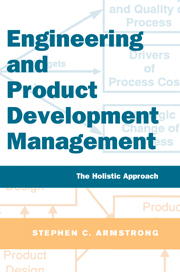Book contents
- Frontmatter
- Contents
- List of figures and tables
- Forewords
- Preface
- Acknowledgments
- Layout of book at a glance
- PART 1 UNDERSTANDING ENGINEERING PROCESS MANAGEMENT
- PART 2 APPLYING ENGINEERING PROCESSES TO PROGRAM MANAGEMENT
- PART 3 DEPLOYING ENGINEERING PROCESS MANAGEMENT
- 12 Organizing for deployment
- 13 Overcoming resistance to change
- 14 Implementing IPD – Lessons learned case study
- PART 4 APPENDIXES
- Glossary
- References
- Index
14 - Implementing IPD – Lessons learned case study
Published online by Cambridge University Press: 05 April 2014
- Frontmatter
- Contents
- List of figures and tables
- Forewords
- Preface
- Acknowledgments
- Layout of book at a glance
- PART 1 UNDERSTANDING ENGINEERING PROCESS MANAGEMENT
- PART 2 APPLYING ENGINEERING PROCESSES TO PROGRAM MANAGEMENT
- PART 3 DEPLOYING ENGINEERING PROCESS MANAGEMENT
- 12 Organizing for deployment
- 13 Overcoming resistance to change
- 14 Implementing IPD – Lessons learned case study
- PART 4 APPENDIXES
- Glossary
- References
- Index
Summary
In this chapter, we will study an engine manufacturing company we will call ACME Engines as it begins to adopt a new integrated product development process based on concurrent engineering and integrated product teams around 1998. There are risks in implementing sweeping changes within an organization. One very real risk comes from thinking of the implementation in too narrow a context. One of the fundamental bodies of knowledge upon which this book is based is concurrent engineering (CE).Many managers will confuse a simple CE implementation with the holistic approach to engineering process management discussed in this book.
In implementing the changes, ACME observed that CE and IPT theories are being embraced across the aerospace and automotive industries. However, they also observed that implementation requires changes to howthey organize, manage, and perform the engineering activities. These changes were not well understood nor accepted. As described in a Fortune magazine article, “The Trouble with Teams” (September 5, 1995), many other companies have also found the transition to teams to be much more difficult than expected. The director responsible for leading the changes at ACME emphasized, “Our biggest blunder was to underestimate the impact of organizational resistance to change.” They indicated initially that the team approach may not seem to be as efficient as the old approach but that they are beginning to see now that it eventually provides superior results.
- Type
- Chapter
- Information
- Engineering and Product Development ManagementThe Holistic Approach, pp. 238 - 248Publisher: Cambridge University PressPrint publication year: 2001



